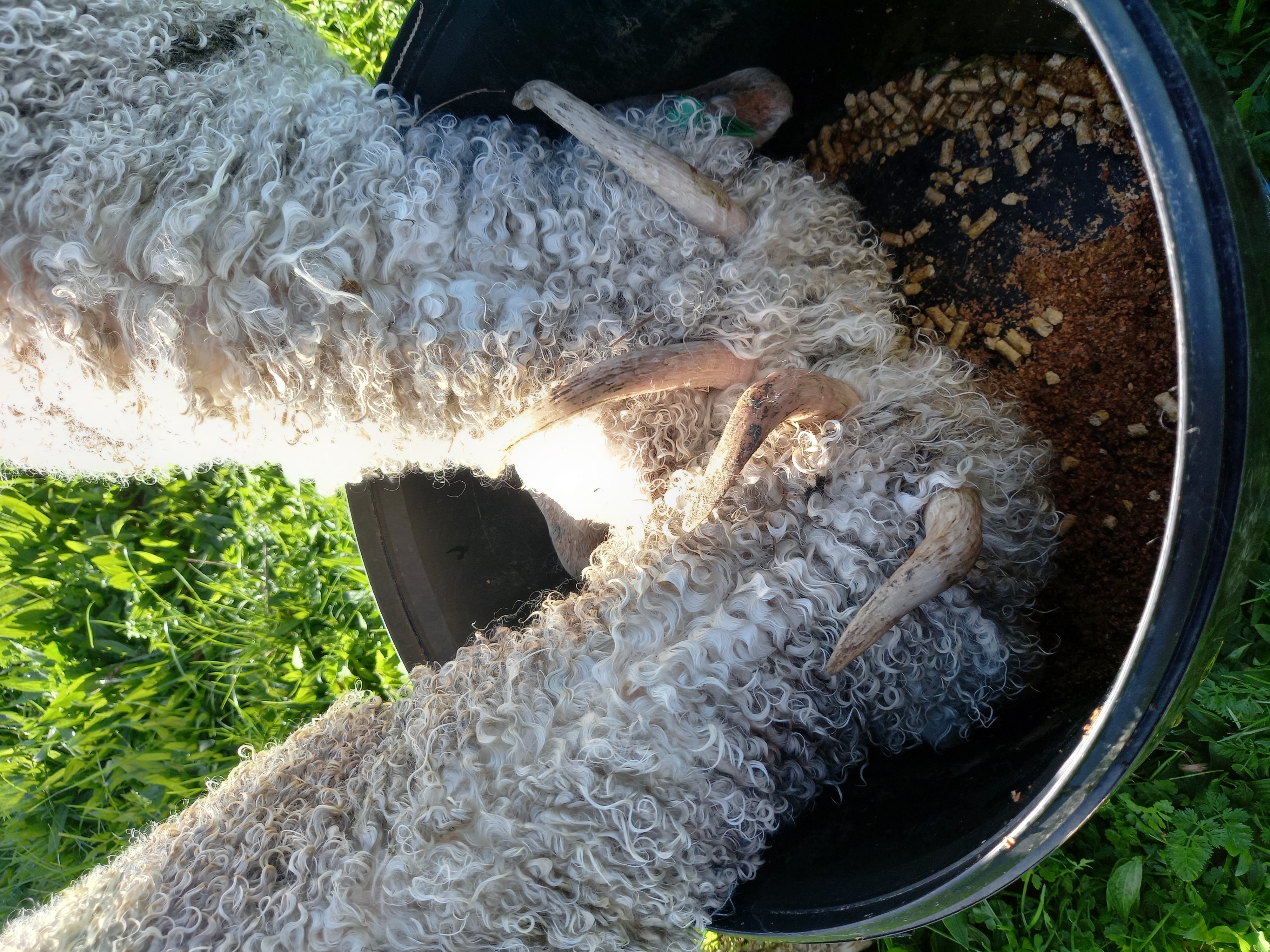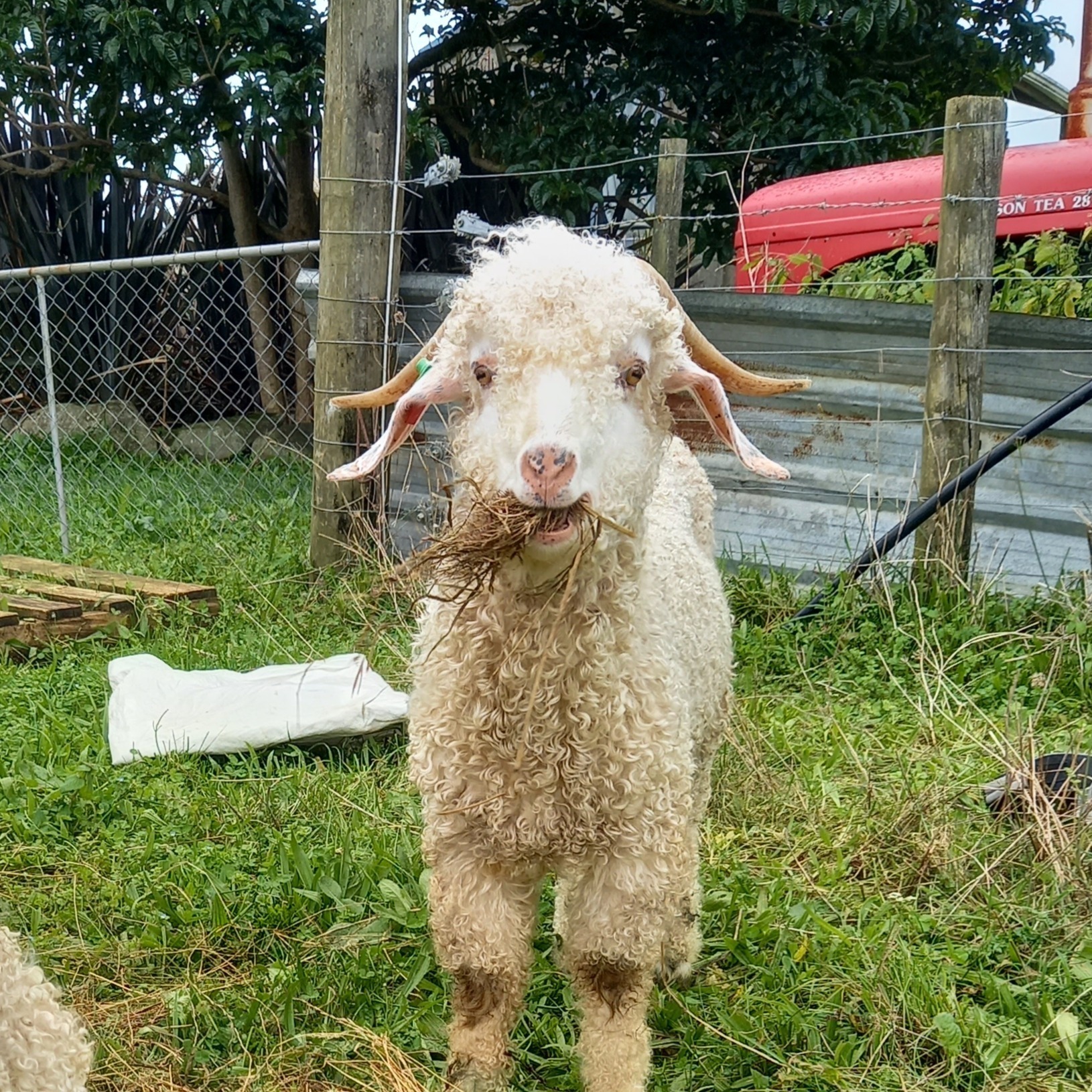Angora Nutrition

There is a misconception that goats will survive on anything. This has been proven to be false. While they do enjoy consuming weeds and scrub which are unpalatable to sheep and cattle, they will still need a diet which is nutritious. Healthy diets for goats will include herbage, grass, and some mineral supplementation.
If you are farming Angoras for fleece production, then good nutrition is essential at all times. Angora goats are only as good as what they consume.
Does need to have adequate nutrition during pregnancy so that they themselves can stay in good condition, as well as grow strong kids, and maintain a good milk supply following birth. Bucks will need high levels of feed and nutrition leading up to, and during, the mating season.
Angora goats love lucerne, all rye grasses, and other modern versions of grass. Angoras prefer a variety of species in the pasture to pick and choose from. They will probably eat around clover, choosing plantain, chicory, rye, or other grasses instead. As well as grazing, they enjoy both grass and maize silage. They love winter growing prairie grass too. They do not compete strongly with sheep and cattle for the “good” grass, instead preferring to take in a wide number of plant species. This can be beneficial to farmers because they will happily consume weed species like thistles and gorse. They cannot live on weeds alone though so make sure you give them the opportunity to graze richer foods alongside the tougher stuff.
Weed Control
Goats will consume plants that other farm stock will not. This makes them the animal of choice with farmers who are contemplating moving away from herbicidal sprays. Some farmers use systems that incorporate wethered goats to control larger blocks of land with lots of weed species. Wethers (castrated males) are chosen instead of does because there is no risk of them becoming pregnant from feral bucks. The goats are still able to grow beautiful mohair when being used primarily for weed control, so this is a win-win for farmers. A win-win-win when you consider that the cost of buying the herbicide is saved as well!
Angora goats are best suited to weed control of scrub blocks in the months following shearing. While the fleece is short, there is less risk of them becoming tangled in gorse or blackberry bushes. There is also reduced contamination from twigs and leaves, which makes skirting at shearing time easier. If the goats cannot spend the last month or two prior to shearing on clean pasture, this is fine, but you must be more vigilant in checking that they haven’t become stuck in a blackberry bush.
Water
Water is one of the most important aspects of a goat’s diet.
Goats do not like stagnant or dirty water and will travel long distances to find a clean water source if needed. Make sure that water troughs are cleaned regularly, and that they are at a height that kids can access.
Please ensure that any deep throughs have a way for small animals (kids) to get back out if they fall in. Kids love exploring and jumping, which sometimes involves jumping on the edge of troughs to look in. As a precaution, troughs should have blocks put inside that can be used as a platform for any wayward kids to use to save themselves.
Rotational Grazing
Rotational grazing keeps pastures at an even length, allowing for faster recovery times while still producing grass with high nutritional value. It also means that goats cannot eradicate species that they find especially tasty, because they are moved on and the plants have time to recover before they return. All farmers should implement correct rotational grazing management, whether it is for a small property, or larger runs requiring weed and scrub management.
Rotational grazing is a farm management system which incorporates how long animals are allowed to graze in one paddock before being moved to the next. Stock are moved from one paddock to the next, on a regular basis in a rotational pattern, so that once the ‘last’ paddock has finished then the ‘first’ paddock is ready for stock again. This paddock grazing system allows for even amounts of feed available at all times, allows grass to recover between stocking periods, and keeps feed at high nutritional values. Following goats with cattle in this pattern is also extremely effective for managing internal parasites.
It is also the most effective way to save areas of pasture for special periods, such as for when your does are in the last few weeks of their pregnancy, which can be done by removing that area out of the last rotation period. Or in times of rapid grass growth, paddocks can be set aside to cut hay or silage from.
Supplementary Feeding
The necessity for supplementary feeding in addition to grazing is dependent on many factors, including: the type of property, the number of Angoras present (stocking rate), and any adverse weather events.
If your farm has limited pasture or high stocking rates, additional supplementary feed will be necessary.
If your goats have access to large amounts of nutritious pasture, then supplements may not be required. Although, it is widely believed that all goats do better if some dry bulk fibrous material is included in their diet, which could be provided in the form of hay.
Hay is fairly cheap when the dry matter content is considered. It does not contain high levels of nutrition (ie, goats cannot survive on hay alone), but it is excellent roughage for the health of your goats digestive systems. The rumen is full of bacteria which break down the long chains of plant matter, and then the goats are able to digest the smaller by-products. The very reaction of the bacteria with the hay creates warmth which can keep your goats toasty and warm on cold nights! So for brisk winter nights, hay is absolutely marvellous for your goats wellbeing.
Hay can also be used in Spring, when the rush of new growth can be dangerously lush for goats. The hay ration acts as a filler reducing the amount of pasture which is consumed.
Goats love eating lucerne hay, and hay baled from the pea vines left over following pea harvest. Silage is a great supplementary alternative to pasture but must be harvested correctly. During the harvesting of silage, care must be taken to ensure that the ground is not disturbed, as dirt could contain the bacteria Listeria which is lethal to goats. Contractors won’t want to cut dirt into your bales/stack because it will blunt their blades, but if you are cutting from an uneven paddock or a hill, it is worth double checking with them that the mower is cutting well above ground level.
Grain supplementation can be very effective in times of drought and bitter cold, although it is recommended to introduce grain gradually. In the final month of pregnancy and the first month of lactation it can be used as a high energy feed for does.
Supplementary feeds like multinuts provide great nutrition and may also be used to modify animal behaviour with training. There are many types of stock nuts available on the market, each with different nutritional values, although all must be gradually introduced to stock.
These nuts may be used to tame angora goats, especially young bucks, by gaining their trust. This keeps their temperament modest, so that they are not so hard to handle later on when it comes time to shear, drench, or treat their feet. They are very responsive to this kind of training.
During the pregnancy and lactation periods, does must have high levels of nutrients, as it is essential to produce milk and overall animal health. This can be done through adding good hay, haylage, nuts, or grain to their diets if there is not enough pasture available.
Overfeeding
Care must be had when feeding goats, as over consumption of pasture or supplementary feed can lead to acidosis, which causes death. Acidosis is caused by stock overeating lush pasture growth during spring, although this risk may be reduced by removing stock after a short period of time or supplementing their diet with hay. Supplementary feed supplies, especially energy rich foods like multinuts, must be stored in an area that the goats cannot access.
Mineral Supplementation
For vigorous normal growth, good bones, strong teeth, and high-quality mohair fibre, your angora goats should have free access to a salt block. (Note, this product is for illustrative purposes only. Mohair NZ is not affiliated with the seller in any way. There are many more options on the market). Salt licks (or mineral licks) contain a mixture of minerals necessary for goat health, most importantly iodine, but also including other trace elements (such as selenium, copper, cobalt, etc.). Salt is essential to all living animals, and iodine is essential to the formation of the mohair follicles, even before the kid is born. Position these blocks close to the animal’s water source.
Loose mineral licks are another option. These are better in the sense that the goat does not have to spend ages licking to get what they need, so sick or timid goats can quickly obtain it. They can also be mixed in with other supplementary feeds to fortify them, such as dried distillers’ grain or palm kernel extract. When loose licks are offered ad-lib, at first they can be gorged on by the goats, so thinning them out with plain salt is necessary when they are first introduced. Here is an example, (deer because it contains copper, essential for angora goats but the goat mix is generalised with sheep, which can’t handle copper) but again, Mohair NZ has no affiliation, and this is for illustrative purposes only.
Finally, some drenches come with a mineralised version which can be handy in making sure all your goats across the board are getting mineral supplements.

